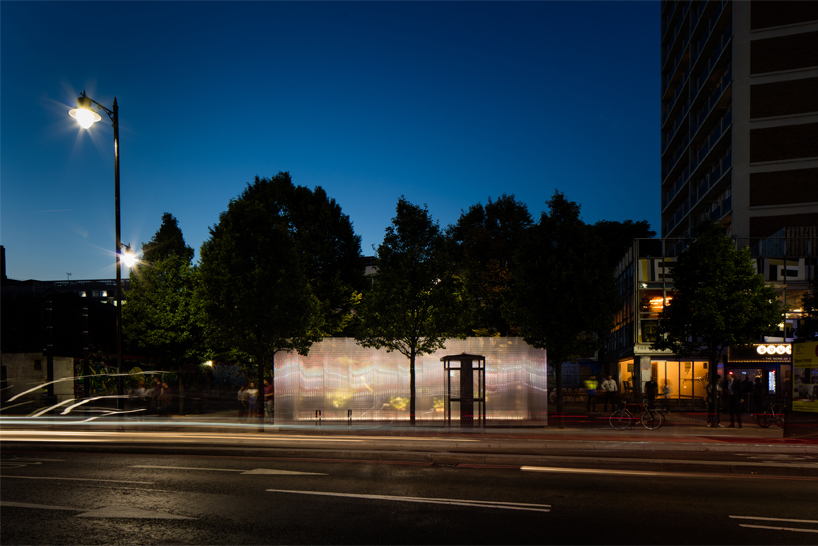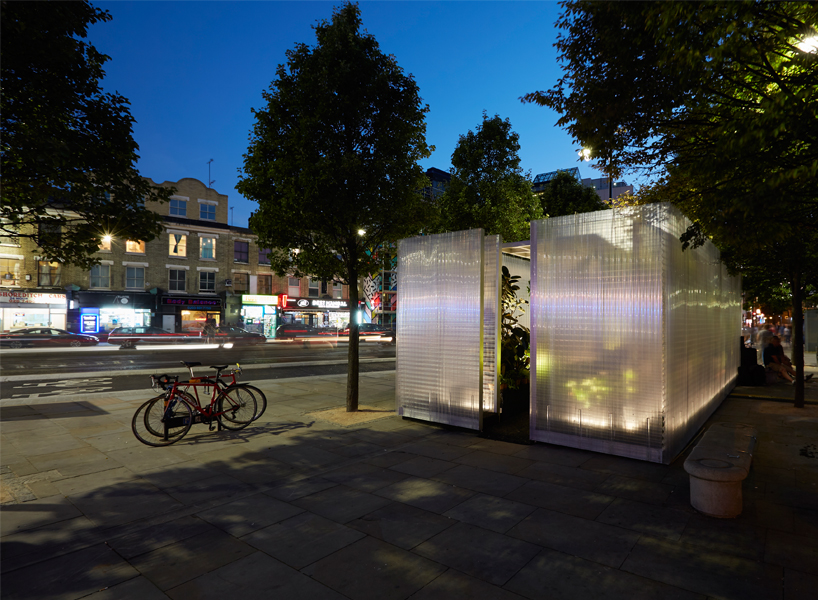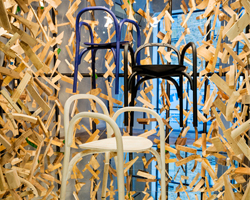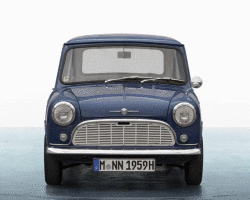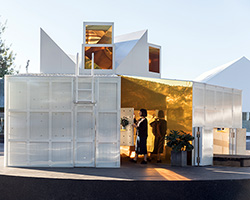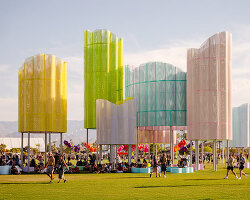london design festival: during the 2016 london design festival, MINI and architect asif khan challenge the future of urban society with the MINI LIVING ‘forests’ installation. particularly thought-provoking the ideas of public and private spaces, the exhibit in shoreditch, presents three community areas; ‘create’, ‘connect’ and ‘relax’. these spaces create additional places outside of the home and working environments, which people can use as social, meet-up and collaborative working points.

architect asif khan (left) and chief lead at MINI LIVING oke hauser (right) inside the create space
as mentioned in our coverage from the press preview day for the MINI LIVING ‘forests’, the installation is open to the public for nine days from the 17th to the 25th september, and is a landmark for the london design festival. the temporary urban exhibit encourages people to mix as a community, in a group of spaces that are comfortable, inspiring and abstract to the normal streets of the city. to do this, architect asif khan sourced the japanese idea of ‘shinrin yoku’, meaning forest bathing, to surround visitors in a sensory woodland experience.

MINI LIVING london design festival 2016
image © designboom
to find out more about the ideas behind the MINI LIVING philosophy, the ‘forests’ installation and the pressing issues of the future of urban society, designboom talked with creative lead at MINI LIVING oke hauser, and architect asif khan.
designboom (DB): first of all, could you tell us more about the forests installation and the idea behind the project?
oke hauser (OH): MINI LIVING is basically our on-going program that investigates the challenges of urban life in general, and especially in the focus of the living and housing concepts. the ‘forests’ installation is the next step after our first one at the salone del mobile, where we tried to focus on the idea of living with a small personal footprint and the inspiring concept of housing cluster communities. taking this idea further, what if we can extend our personal space to be shared in the public with other people and to create more flexibility within our lives. as a result from this, in the future, it would give us more time and much more joy. however, this is also about solving some serious issues like over-crowding cities and rising rent prices, which is a focus point for our project. we see this as a contribution, a start to thinking about spaces differently within cities. as well, this shows our angle from the brand perspective, as our cars consider how to work with small spaces and we tried to transform this into different design fields like architecture. this has helped to think creatively about public spaces.

the create space at dusk
DB: can you discuss the three different spaces and explain how they differ from each other?
OH: the three, they actually seem more cut-out examples of all different functions. overall, the three spaces are an idea to see if we can out-source activities away from our apartments, but they could easily reflect different functions as well. I think that even though they are; create, relax and connect spaces, they are also little interpretations for each of us. we all work in different ways, sometimes in a more calm mode for example, so really the spaces are all up to interpretations for the user.
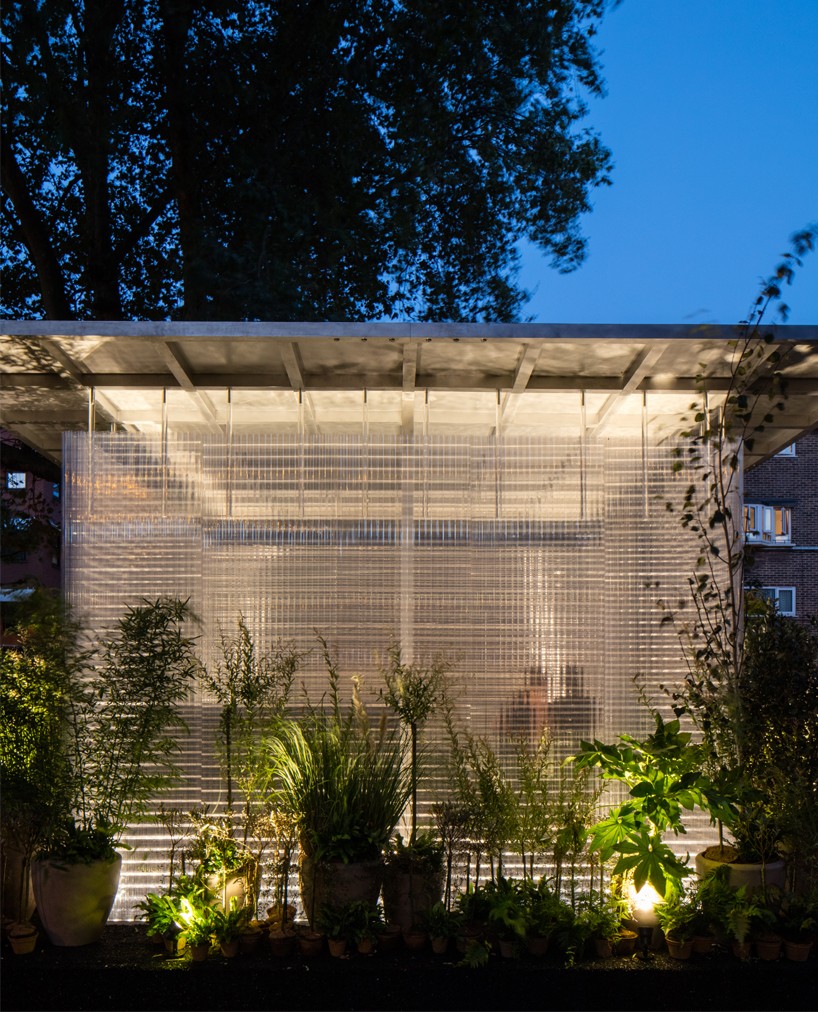
the space enables people to collaborative create
asif khan (AK): it is a very nice brief to have. three specific typology of topics for how to manage a space being used for relaxation, connection and creation. they are quite broad ideas and actually, in reality, all spaces are hybrids of many different typologies. of course, this is a kind of work environment that we are in at the moment (the create forest), but we could also have a conversation like this in the relax and connect space. I think that also the time of the day and people’s frames of mind, will determine how the spaces will be used differently. we are trying to provide triggers to encourage different types of use.
we all know that when we walk in this city, we try and grab the moment to find a place for work. you get a phone call, you get an email, where can I sit, where can I do this? we all find that situation really familiar, and often places like parks, which are perfect for certain types of activities and frames of mind, doesn’t fulfill the activity you need to do at that time of the day in this modern society. this project is about exploring and stretching the use of public spaces so that citizens can get more from it. it is catering more for spaces that you would typically have at home or at work.

the connect and relax spaces are right on a london street’s pavement
image © designboom
DB: why was this project targeted specifically for london, was it in the brief to tie in with the festival or was it specifically for the city’s working life and society?
OH: what triggered us was the chance to use the london design festival as an international platform because it is very important. however, from a conceptual point of view, london is one of the…
AK: greatest cities on earth!
OH: well, one of the most expensive cities. there is an idea of how we can actually make living spaces more affordable again in those kind of cities. new york and paris are more examples of the same sort of price range. it is really about this issue of how creative people are being pushed out to the suburbs and need to commute in. we have to find a solution for these creative people in cities all across the globe. we have to provide answers for more affordable housing in the future. we think that to get a flexible resolution with small personal footprints, means additional space has to be activated for personal use for temporary amounts of time. overall, I think that creating a more enjoyable city life is a very big topic for the future.
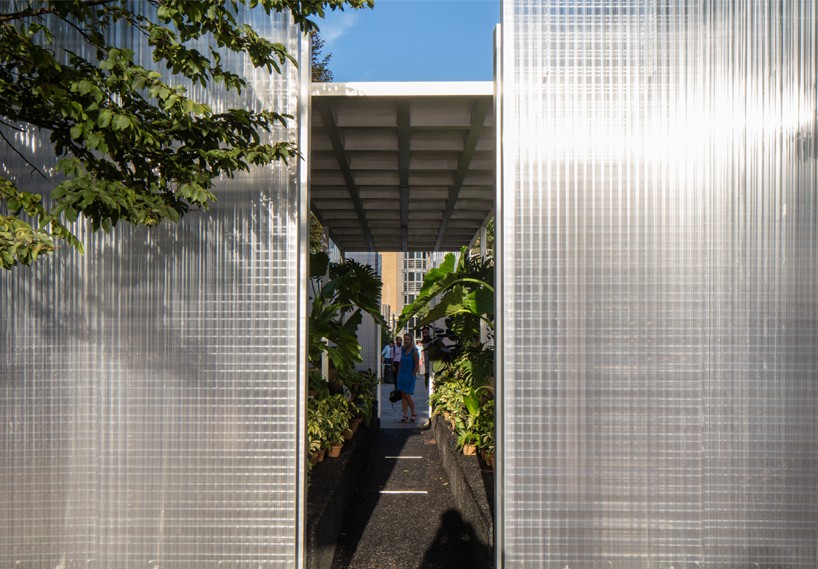
the public can take a break from walking in a forest sanctuary
AK: I might add something to that. it is not just about creative people meeting other creative people in the spaces. it is about them being inspired and influenced by everyone else in the city.
OH: exactly.
AK: if you put all these communities into the sides and away from each other, then there is no development, there is no possibility and no creativity actually.
OH: cities are all about complexity. they are about getting inspired by different people and mind sets. there is a saying that in cities you live with strangers, but that is actually what it is all about, it is about the casual encounters. this is also where inspiration comes from. inspiration might even come from talking to different professions. that is what the spaces provide. for example, the connect or create spaces make these improvised encounters, which basically result in those inspirational moments.

the connect exhibit
image © designboom
DB: as this will be open throughout the festival, how do you expect people to interact with the spaces and do you worry that people will stay here for long periods of time and discourage inclusion?
AK: the three spaces are put out into the public and two are essentially on the pavement. we all use pavements and street furniture casually and intuitively, so these two spaces (relax and connect) are out into the same concept but in a slightly new format that we need to learn about. it is a different setup that we have to discover, but that is why we have used the plant material to let people encounter something very familiar. there are plants that people have in their own homes or gardens. this brings domestic spaces into the city. we don’t know what will happen in the spaces but we are very excited. in the connect space there are going to be dinners, events and some really cool programs. the passing by public can just join in and it is the same in this (create) space as well.
yesterday, we found that even on the photography day, people were wondering up into the relax space and just sitting there. some guys came past in their lunch break, went in there and then left. some kids went in there on their way back from school. a lady who lives near here, read about it and wanted to have a look. it will all start quite tentatively but then people will realize that they can sit here and use it. I can call my friend and we will meet here, and it will become a landmark. that is the nice idea about these landmark projects. they are actually in the minds of the local community, they are places, and that is very important as they become significant landmarks in the local culture. sadly, there are only nine days to do this experiment.

DB: could you tell us more about the upcoming MINI LIVING project in brooklyn, new york, later this year?
OH: the brooklyn project, A/D/O, is more about a general approach of integrating all kinds of disciplines from the creative fields. it is a hybrid space, in a renovated bakery factory, that will integrate the start-up acceleration, a small educational, academic institution and will also be a design and art venue. it is more about urban design and how we can create living solutions for the future.

the public are encouraged to climb into the relax space
image © designboom
DB: what will happen to these spaces after the nine days?
AK: they are being taken apart because we are only allowed to keep them up during the festival. as I explained earlier, the good things about this is that when something is up fleetingly, you enjoy it much more. as an event, things are experienced far more intensely and there is far more willingness to discover this space and draw something from it and move on. of course it is sad that it has to go. it would be very nice if there was a way of keeping some of the spaces here. I feel that the small one, the relax space, would be amazing to keep.
OH: there was a very strong support from the council for this project. at MINI we always try to leave some kind of footprint behind and not just disappear. we try and bring something valuable to the area we work in. hopefully we can find a solution for future of this project.

the space provides an escape from the busy urban environment
image © designboom
DB: asif, this project has given you the chance to work with MINI, the automotive brand, how did this change your mind set when working with a client you are not commonly use to?
AK: I think it always very nice to work with different people. I don’t usually see a brand, I see human beings as our clients. there is a correspondence, a communicate, a dialogue about what the project can be. when you work on something like this, there is a search to push something further, to discover something that hasn’t been done before. earlier, I had a question about what is innovation and I said innovation is not interesting, it is about the unknown that is interesting. for us, it is to challenge the unknown and create things which haven’t been created before. that was a willingness MINI showed by enabling this to happen and an interest that I believe in enormously – to push boundaries. this is not just for the sake of it but to discover what is possible if we challenge the idea of public space and private space. as well, this project was about challenging what festival content can be, because it is not normal to make spaces like this actually. they are making exhibits, they are making pretty beautiful things which have very strong material experimentation, but in the past, there hasn’t been the opportunities to make things about contemporary, urban issues, which this is about, and that is what is nice to explore with MINI.


lusciously green plants provide a relaxing and contrast space in the city
